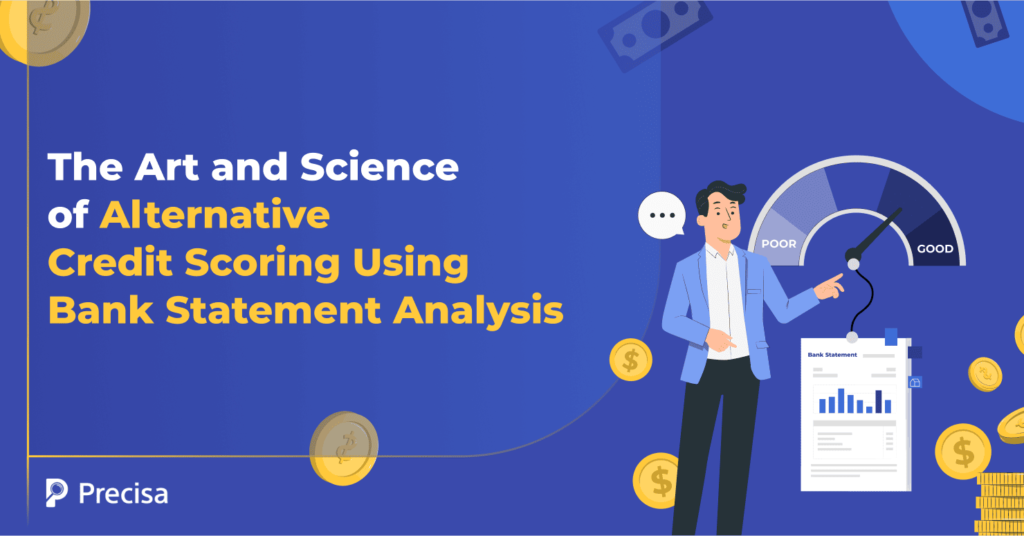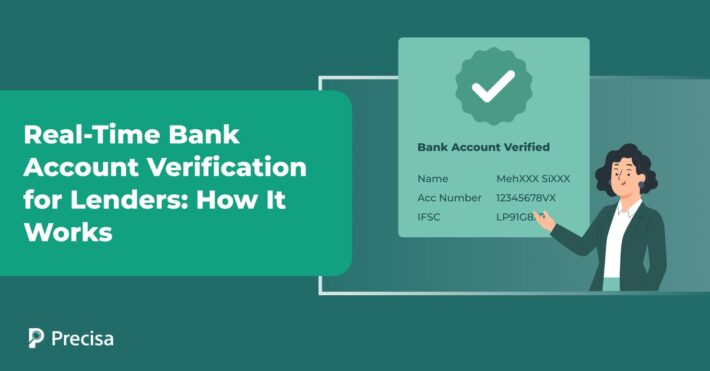Alternative Credit Scoring Using Bank Statement Analysis

Why is alternative credit scoring gaining momentum in India? Before exploring the reasons, let’s take a quick look at the context.
Lenders disbursed over 383 million loans in FY 23-24 alone. Even though the financial market has shown this phenomenal growth, more than 160 million Indians remain “credit invisible”. In fact, 22% of Indian adults are still unbanked. Yet most of them have good salaries and pay their bills on time.
This limited visibility into their spending and financial behaviour has made this population segment largely “unscorable” through the traditional methods. In this scenario, alternative credit scoring methods, such as AI-led bank statement analysis, can solve this problem.
How? Let’s explore.
What is Alternative Credit Scoring
In the alternative credit scoring approach, banks and lenders use non-traditional data sources to check an applicant’s financial health and capabilities. Instead of using only credit bureau reports and CIBIL scores, lenders review multiple digital footprints.
These are as follows:
- Phone, fuel, and electricity bills
- Monthly rental
- Salary credits or other income sources
- UPI transactions
- Smartphone metadata
- Maintenance of account balance
- Social media credit signals
- EMI payments and their bounce rates
- Activities across digital wallets
With alternative credit scoring, lenders can reach individuals who do not have a formal credit history but are responsible in spending their income. This approach is particularly accurate for borrowers like
- Freelancers, contract workers, and gig artists
- First-time loan applicants without any credit history
- Home-based business owners
- MSMEs and small-business owners
- Self-employed job workers, like plumbers and nannies
Since the approach provides a 360° view of customers’ financial profiles, it helps lenders improve accuracy and lending decisions, and inclusivity, and reduce risks.
Why Lenders are Shifting Towards Alternative Credit Scoring Models
Interestingly, traditional models, like CIBIL, Experian, or CRIF, only focus on past loans, credit cards, and repayment history. However, in India, people prefer receiving cash as salaries or other means instead of bank transfers.
Alternative credit scoring is happening faster than ever because of the benefits it offers:
[table id=11 /]
How Bank Statement Analysis Empowers Alternative Credit Scoring
Even though bank statements contain thousands of raw and unorganised transactions, they are extremely important for revealing a borrower’s true financial behaviour. Modern analysis tools convert this raw data into meaningful and actionable insights within minutes.
Here’s how bank statement analysers help lenders:
1. Recognise Comprehensive Transaction Pattern
Advanced algorithms can scan thousands of scattered and unorganised transactions automatically in real time and categorise them into various segments for easy interpretation.
This includes regular income sources with amounts and dates, monthly fixed expenses, such as EMIs, rent, and electricity, diverse spending, such as groceries, travel, and food, expenses made in discretion, like e-commerce purchases, and any income fluctuations that may impact the cash flow.
2. Show an Exhaustive Cash Flow Evaluation
Bank statement analysis can generate comprehensive cash flow profiles of different applicants, showing the following:
[table id=12 /]
3. Detect Risks in Real-Time
Sophisticated algorithms can mark potential risks based on various criteria and assign scores.
- For instance, too many overdrafts may indicate cash flow issues, while ATM withdrawals twice or thrice a week may show cash dependency.
- Similarly, applying for loans too often indicates overspending, and multiple round-number transactions are generally considered suspicious activities.
Features that Make Modern Bank Statement Analysis Tools Effective
Advanced bank statement analysis tools infuse AI and machine learning and combine security, speed, and insights to make alternative credit scoring more effective for lenders.
Here are the important features that they must consider:
1. Smart Parsing
OCR technology reads PDF statements from all major Indian banks. Lenders can extract transaction data with 99% accuracy and reduce manual data entry errors and processing delays considerably.
2. Clean Transaction Categorisation
Machine learning algorithms automatically tag recurring income, utility payments, and EMI debits into respective categories. They further segregate transactions, like investment activities, wealth building, entertainment spending, food, and other essentials, for detailed analysis.
3. Risk Scoring Models
Advanced platforms, like Precisa, generate customised creditworthiness scores ranging from 0 to 1000 or 1 to 10 based on:
- Consistency of payment across different time periods
- Income graph, whether it grew or declined over the months
- Volatility of account balance
- How stable is income over a period
These scores complement traditional credit scores by providing real-time financial behaviour insights.
4. Fraud Detection and Irregularity Verification
Automated flagging algorithms identify concerning activities like:
- Bank balances inflated artificially before the loan application
- Repeated number of circular transactions between similar accounts
- Salary credits fabricated or misguided information
- PDF statements forged through sophisticated image editing tools
- Equal debits and credits, which might be due to money rotation
- Cheques deposited on national holidays
5. Customised, Data-Driven Risk Profiling
Since standardised lending rates and products are not able to serve diverse audiences effectively, an emerging solution for financial inclusion is tailored loan products.
As such, alternative credit scoring using bank statement analysers helps lenders to design borrower-specific risk profiles based on real bank data.
Instead of one-size-fits-all models, lenders tailor loan offerings, including smaller ticket sizes that align with the borrower’s actual cash flow and repayment capacity.
Final Thoughts
The RBI has been actively encouraging digital credit assessment. Account aggregators like Sahmati and India Stack make it easier for financial institutions to access verified user data (with consent).
Alternative credit scoring, backed by intuitive bank statement analysis systems like Precisa, is aligned with this shift toward an open and inclusive credit system.
Precisa’s cloud-based analytics solutions and dynamic scoring models are helping lenders expand clientele beyond traditional profiles, speed up loan approvals, and manage risk smarter, all while keeping operations lean.
With its streamlined module fully integrated into loan origination systems, you can gain a new perspective of your applicants and improve portfolio allocation performance.
Request a free demo to explore Precisa’s advanced credit scoring features!




